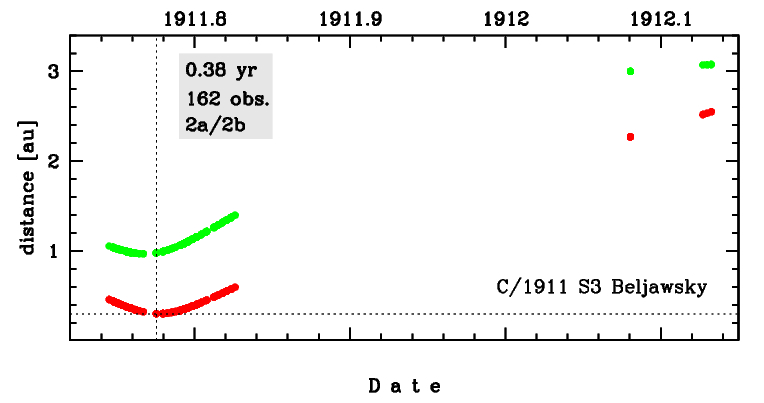C/1911 S3 Beljawsky
more info
Comet C/1911 S3 was discovered on 29 September 1911 by Sergei Ivanovich Beljawsky (Simeis Observatorym Crimea, Ukraine), that is 11 days before its perihelion passage, and it was last seen on 17 February 1912 [Kronk, Cometography: Volume 3].
This comet made its closest approach to the Earth on 7 October 1907 (0.969 au), that is three days before its perihelion passage.
Solutions given here are based on data spanning over 0.386 yr in a range of heliocentric distances from 0.462 au through perihelion (0.303 au) to 2.549 au.
Pure gravitational orbit determined from all available positional measurements (162 observations) give 2a-class orbit similarly as in Minor Planet Center (66 obs. used, the same arc of data; see https://www.minorplanetcenter.net/db_search).Using the purely gravitational model of motion the original barycentric orbit is hyperbolic; similar type of solution was obtained by Marsden, Sekanina and Everhart (1978, see also MPC).
It was possible to determine the non-gravitational orbit for C/1911 S3 (preferred orbit); the decrease of RMS is noticeable (from 2.35 arcsec to 2.10 arcs, see below) though only radial non-gravitational parameter was determined. The derived NG solution give original barycentric 1/a shifted towards significanly larger values, that is to considerably smaller semimajor axis. According to this NG solution C/1911 S3 have nominal orbit with semimajor axis of about 1300 au.; however, the accuracy of this NG solution is very poor (orbit of 2b-class, see preferred orbit).
This Oort spike comet suffers rather small planetary perturbations during its passage through the planetary system.
More details in Królikowska et al. 2014.
This comet made its closest approach to the Earth on 7 October 1907 (0.969 au), that is three days before its perihelion passage.
Solutions given here are based on data spanning over 0.386 yr in a range of heliocentric distances from 0.462 au through perihelion (0.303 au) to 2.549 au.
Pure gravitational orbit determined from all available positional measurements (162 observations) give 2a-class orbit similarly as in Minor Planet Center (66 obs. used, the same arc of data; see https://www.minorplanetcenter.net/db_search).Using the purely gravitational model of motion the original barycentric orbit is hyperbolic; similar type of solution was obtained by Marsden, Sekanina and Everhart (1978, see also MPC).
It was possible to determine the non-gravitational orbit for C/1911 S3 (preferred orbit); the decrease of RMS is noticeable (from 2.35 arcsec to 2.10 arcs, see below) though only radial non-gravitational parameter was determined. The derived NG solution give original barycentric 1/a shifted towards significanly larger values, that is to considerably smaller semimajor axis. According to this NG solution C/1911 S3 have nominal orbit with semimajor axis of about 1300 au.; however, the accuracy of this NG solution is very poor (orbit of 2b-class, see preferred orbit).
This Oort spike comet suffers rather small planetary perturbations during its passage through the planetary system.
More details in Królikowska et al. 2014.
| solution description | ||
|---|---|---|
| number of observations | 162 | |
| data interval | 1911 09 29 – 1912 02 17 | |
| data type | perihelion within the observation arc (FULL) | |
| data arc selection | entire data set (STD) | |
| range of heliocentric distances | 0.46 au – 0.30 au (perihelion) – 2.55 au | |
| type of model of motion | NS - non-gravitational orbits for standard g(r) | |
| data weighting | YES | |
| number of residuals | 244 | |
| RMS [arcseconds] | 2.10 | |
| orbit quality class | 2b | |
| previous orbit statistics, both Galactic and stellar perturbations were taken into account | ||
|---|---|---|
| no. of returning VCs in the swarm | 1274 | * |
| no. of escaping VCs in the swarm | 3727 | |
| no. of hyperbolas among escaping VCs in the swarm | 3198 | * |
| previous reciprocal semi-major axis [10-6 au-1] | -77.93 – -15.92 – 42.73 | |
| previous perihelion distance [au] | 0.55 – 1300 – 3700 | R |
| previous aphelion distance [103 au] | 30 – 74 – 420 | |
| time interval to previous perihelion [Myr] | 1.5 – 4.4 – 11 | R |
| percentage of VCs with qprev < 10 | 23 | |
| percentage of VCs with qprev > 20 | 77 | |
| previous_g orbit statistics, here only the Galactic tide has been included | ||
|---|---|---|
| no. of returning VCs in the swarm | 1236 | * |
| no. of escaping VCs in the swarm | 3765 | |
| no. of hyperbolas among escaping VCs in the swarm | 3173 | * |
| previous reciprocal semi-major axis [10-6 au-1] | -78.55 – -17.01 – 42.82 | |
| previous perihelion distance [au] | 0.4 – 3.7 – 160 | R |
| previous aphelion distance [103 au] | 30 – 76 – 410 | |
| time interval to previous perihelion [Myr] | 1.5 – 4.3 – 11 | R |
| percentage of VCs with qprev < 10 | 64 | |
| percentage of VCs with 10 < qprev < 20 | 7 | |
| percentage of VCs with qprev > 20 | 29 | |
